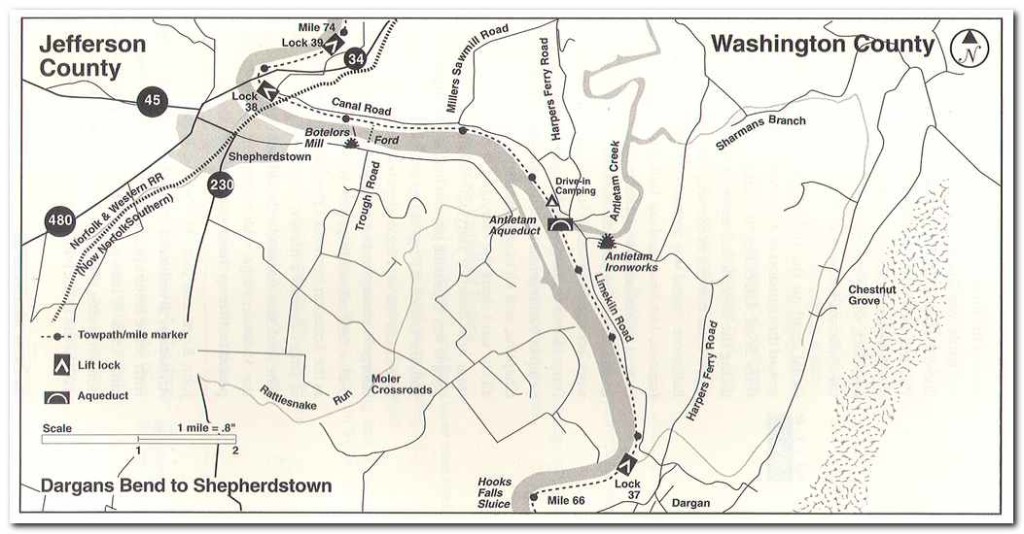From here it was another 7.8 miles to the town of Brunswick (milepost 55). Originally named Berlin it was the site where the Union Army of the Potomac returned to Virginia following both the Battle of Antietam and Gettysburg. I stopped for the night, after 19.5 miles made that day and anticipating my hike to Harpers Ferry the next day.
The next day, my fourth on the canal, I started out at 9:30 and headed for Harpers Ferry. At milepost 57.8 I passed through a notch in a small ridge just before Blue Ridge, known as South Mountain in Maryland and Short Hill Mountain in Virginia. South Mountain is geographically and historically significant because of the battles fought in the mountain gaps just about 10 miles north of here as Confederate forces tried to delay General McClellan’s advance on Lee’s army at Antietam in September 1862. At milepost 58 is the marker for the Appalachian Trail. The trail follows South Mountain through Maryland to the Potomac, and merges with the towpath for the next several miles. At milepost 60.6 I passed by the confluence of the Shenandoah River and the Potomac River a short distance from Harpers Ferry (milepost 60.7). I climbed the spiral stairs and walked over the Potomac on the railroad bridge into town and had lunch before continuing on toward Antietam Creek.
The walk above Harpers Ferry was one of the prettiest along the canal and by 2:00 I had reached the aqueduct (milepost 69.4) which carries the canal over Antietam Creek. Completed in 1834 this three arch span of limestone is still in good condition, after more nearly 175 years. A short distance away is the town of Antietam and the Antietam battlefield, site of one of the bloodiest engagements of the Civil War. From Antietam Creek the trail continues on for 2 miles to Packhourse Ford/Botelers Ford. This was one of the most raveled fords on the Potomac and its use dates back to the mid 1700s. The Confederate army made frequent use of the ford to maneuver up and down the Shenandoah Valley. The better part of the Confederate army used the ford during the Gettysburg campaign and Jubal Early crossed here to begin his raid on Washington in 1864. The most famous crossing took place on September 17th 1862, after the battle of Antietam. While a small force kept campfires going along the Confederate lines at Sharpsburg, the main body of Lee’s army began massing here on the night of the eighteenth to cross back into West Virginia. As the last division crossed in the morning’s light, they were surprised to see Lee himself sitting on horseback in midstream ushering them on.
Sheperdstown Lock #38 (milepost 72.5). The this point the river begins several sharp bends in the river as it way through the hills toward Williamsport. On December 3, 1787, twenty years before Robert Fulton unveiled the Clermont, James Rumsey demonstrated a working model of a steamboat along this stretch of the Potomac River. The early winter demonstration drew a crowd of skeptical townspeople. No one was convinced that the eccentric inventor’s “canoe powered by a teakettle” would ever leave the dock. But when it was finally launched from the Shepherdstown side of the river the steamed upriver for about half a mile and then passed downstream of the town before returning to the landing. On December 11th, a second test of the futuristic craft (which used the steam as jet propulsion rather than paddles) achieved a speed of four miles an hour.
Just before the Horseshoe Bend Campsite I passed Lock #40 (milepost 79.4). The lock was severely damaged during a raid by Jubal Early in July 1864.
Pages: « Previous 1 2 3 4 5 6 7 8 9 10 11 12 13 14 15 16 17 18 19 20 21 Next »





